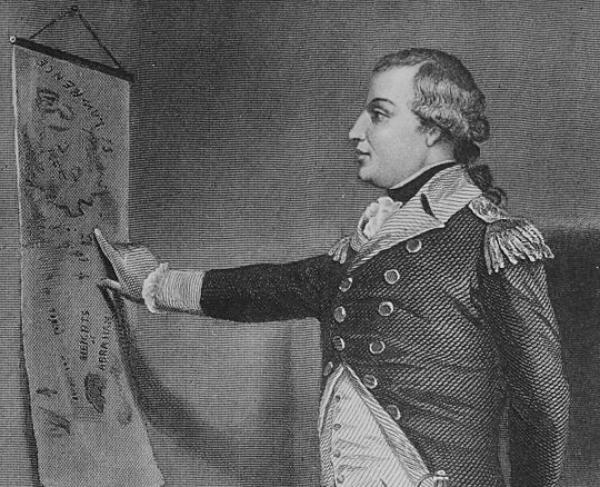
General Richard Montgomery, a highly respected military leader during the American Revolutionary War, played a crucial role in the fight for American independence.
Born on December 2, 1738, in Swords, County Dublin, Ireland, Montgomery’s remarkable military career and notable contributions to the Revolutionary War have left an enduring legacy in the annals of American history.
Early Life
Montgomery’s journey began in Ireland, where he was born, and later ventured into a British military career.
Following this period, he chose to resign from the British Army.
Subsequently, he relocated to New York state, marking the beginning of his involvement in the American Rebellion.
Montgomery’s early life encompassed a transition from his birthplace in Ireland to a military career within the British ranks.
However, a pivotal moment led to his resignation from the British Army, prompting a move to New York state.
It was in this new environment that Montgomery’s path intersected with the unfolding events of the American Rebellion.
- Read also: Uncrowned Ranger: John Stark Revolutionary War
- Read also: Joseph Brant in the Revolutionary War
Seven Years War
North America
Montgomery’s pivotal military experience unfolded during the Seven Years War in North America.
Serving in this conflict provided him with a unique opportunity to hone his military skills and cultivate leadership qualities that would play a significant role in his future endeavors.
The theater of North America presented diverse challenges, from the rugged landscapes to the complexities of warfare on unfamiliar terrain.
Through active participation, Montgomery not only gained tactical insights but also forged alliances and friendships crucial to his later career.
Caribbean
In addition to his service in North America, Montgomery extended his military activities to the Caribbean during the Seven Years War.
This further diversified his experience, exposing him to the unique challenges posed by the Caribbean theater.
The tropical environment and maritime aspects of warfare in the Caribbean offered Montgomery additional perspectives and skills that would contribute to his versatility as a military commander.
Pontiac’s Rebellion
Montgomery’s military journey intersected with Pontiac’s Rebellion, a significant chapter in North American history post the Seven Years War.
This conflict marked indigenous resistance against British expansion, offering Montgomery insights into colonial complexities and guerrilla warfare.
His experiences during Pontiac’s Rebellion influenced his leadership approach, emphasizing the importance of cultural awareness and diplomacy alongside military tactics.
This historical episode played a vital role in shaping Montgomery’s strategic thinking and adaptability, leaving a lasting impact on his military perspective.
Recovery
Following his military service, Montgomery entered a period of recovery and reflection.
This crucial interval served as preparation for the significant role he would later undertake in the American Revolution.
Settling in New York
Montgomery’s decision to settle in New York state became a pivotal moment in his life.
This relocation not only marked a geographical shift but also set the stage for his involvement in events that would unfold into the American Revolution.
The tranquil environment of New York provided him with the space and perspective needed for reflection, ultimately shaping his readiness for the revolutionary role that awaited him.
American Revolution
Appointment
In the unfolding drama of the American Revolution, 1775 marked a significant chapter for Montgomery.
Joining the Continental Army, he assumed the role of major general, a key position that would thrust him into the heart of the impending conflict.
This appointment underscored the trust placed in Montgomery’s military prowess and leadership capabilities.
Plan
Montgomery’s leadership and strategic acumen came to the forefront as he embarked on the challenging task of formulating a plan to capture Quebec.
The objective was ambitious – to unite Canada with the American colonies.
This endeavor demanded meticulous planning, a deep understanding of the terrain, and a keen awareness of the political dynamics at play.
Invasion of Canada
In the execution of Montgomery’s plan, the invasion of Canada took center stage.
The audacious assault on Quebec showcased Montgomery’s unwavering commitment to the cause of American independence.
This pivotal moment would test not only the military might of the Continental Army but also the visionary leadership of Montgomery.
Siege of St. Johns
Montgomery’s military prowess came to the forefront during the Siege of St. Johns, a critical engagement that not only demonstrated his strategic acumen but also showcased his unwavering determination.
This early episode in the American Revolution marked a crucial test of Montgomery’s leadership capabilities.
Montreal to Quebec
His military campaign from Montreal to Quebec further underscored Montgomery’s strategic vision and the profound respect he commanded from his troops.
Navigating the challenging terrains of Canada, Montgomery exhibited not only tactical brilliance but also a keen understanding of the logistical intricacies involved in leading a military expedition over considerable distances.
Attack and Death
Tragedy struck during the attack on Quebec, where Montgomery’s life was tragically cut short.
However, his legacy was etched in the annals of history during this critical juncture.
In the face of adversity, Montgomery displayed unparalleled bravery and leadership, leaving an indelible mark on the minds of those who fought alongside him.
Funeral
Following his untimely death, Montgomery was mourned and honored for his remarkable contributions to the American cause.
His funeral became a solemn occasion to pay respects to a fallen hero.
The legacy of Montgomery’s leadership and sacrifice reverberated through the American Revolution, symbolizing the profound commitment of individuals to the pursuit of freedom and independence.
Aftermath
Montgomery’s contributions and sacrifices continued to resonate in the collective memory of the American Revolution.
His unwavering commitment and leadership during pivotal moments left an indelible mark on the narrative of the fight for independence.
Memorials
In recognition of his heroic service, numerous memorials and tributes have been dedicated to General Richard Montgomery.
These monuments serve as poignant reminders of his significant role in shaping American history.
Whether in the form of statues, plaques, or historical markers, these tributes stand as a collective acknowledgment of Montgomery’s enduring impact.
- Read also: Civil War vs Revolutionary War
- Read also: Understanding the Effects of the Revolutionary War
Conclusion
The life and military journey of General Richard Montgomery stand as a shining example of the valor, leadership, and selflessness that characterized the American Revolutionary War.
His remarkable legacy serves as a perpetual source of inspiration, evoking gratitude and remembrance.
Montgomery’s enduring contributions to the cause of American independence ensure that his pivotal role in shaping the nation’s history is eternally etched in our collective memory.
FAQs
General Montgomery’s most notable military achievement was his leadership during the American Revolutionary War, particularly his pivotal role in the attack on Quebec and his efforts to unite Canada with the American colonies.
General Montgomery’s death was a significant loss for the American cause, but his bravery and leadership in the face of adversity inspired continued determination and commitment among the patriots fighting for independence.


